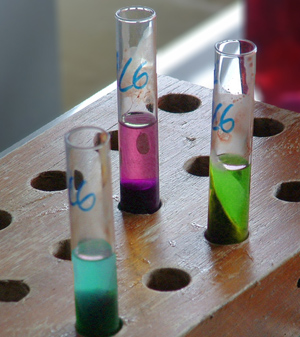
09/23/2010
SUNY Cortland will continue a series of lectures, geared to pique curiosity about chemistry relating to health, the environment, energy and other hot-button topics, with a talk on Monday, Oct. 4, by Eileen Jaffe, a senior research scientist with the Fox Chase Cancer Center in Philadelphia, Pa.
Jaffe, shown left, will discuss “Protein Dancing and Drug Discovery” at 3 p.m. in Sperry Center, Room 106, as part of the series titled, “Current Research in the Chemical Sciences: Stars to Cells to Green Catalysis.”
Sponsored by the Chemistry Department, the Chemistry Club and the Campus Artist and Lecture Series, all lectures and discussions are free and open to the public.
The talks by Jaffe and the two remaining speakers in this series will feature a pre-lecture light reception at 2:40 p.m. in the first floor lobby of Sperry Center outside Room 106. The lectures all begin at 3 p.m. and take place in Sperry Center, Room 106. All conclude with an hour-long post-lecture discussion at 4 p.m. in the Bowers Hall first floor lounge.
“Whether one is interested in the specifics of our speakers’ research projects, the broader fields and applications that contextualize their research, or the opportunities for undergraduates to be involved in current, up-to-the-minute scientific research in varied facilities, we have engineered a program to suit that interest,” said series organizer Karen Downey, a SUNY Cortland assistant professor of chemistry. “We have designed our seminar series to show SUNY Cortland students what is going on around them at comparable institutions, paths that their peer alumni have successfully trodden, and the vast scope of work to which undergraduate researchers can contribute.”
For more information, contact Downey at (607) 753-5732.
 |
| Eileen Jaffe '75 |
Jaffe joined Fox Chase in 2003 and has a bachelor’s degree in chemistry from SUNY Cortland and a doctorate in biochemistry from University of Pennsylvania. She will share breakthroughs in her research.
“Although it is apparent that protein function requires molecular motions, it is generally understood that a protein carries out its function in one specific three-dimensional shape,” observed Jaffe, who completed a postdoctoral fellow at Harvard University and has served at Haverford College, Jefferson Medical College and University of Pennsylvania School of Dental Medicine.
“We have recently discovered that this paradigm does not hold true for all proteins,” she said. “In some cases a protein can dissociate, change shape and reassemble into a structurally and functionally distinct assembly. We call such ‘dancing’ proteins morpheeins. These morpheeins have substantial implications for the development of new antimicrobial therapies and for the understanding of drug side effects in humans.”
On Monday, Oct. 25, Chad Rezsnyak, an inorganic chemist in the University at Buffalo’s Department of Chemistry, will address “Green Alchemy: a Gold-based Approach to Generating Ethanol.”
“In the search for alternative energies, ethanol has attracted attention as a possible supplement to fossil fuels,” Rezsnyak noted.
In general, ethanol can be produced by fermentation or by chemical methods, he said. Fermentation is unsuitable for large-scale production of ethanol, since it is fermented from valuable food commodities. The chemical methods established thus far are also inadequate: they require high temperatures and pressures, and the syntheses are usually conducted under acidic conditions.
“The current research aims to develop a catalyst for producing fuel ethanol from a non-food-based starting material, all in the ‘greenest’ possible non-toxic solvent: water,” he said.
A 2007 SUNY Cortland graduate, Rezsnyak is currently pursuing a doctorate at the University at Buffalo with the goal of becoming a professor of chemistry.
On Monday, Nov. 15, Margaret Logan, an associate professor of chemistry at the College at Brockport, will focus her talk on “Synthetic and Mechanistic Aspects of Palladium-Catalyzed Aryl Chloride Reactions.”
“Palladium-catalyzed reactions of aryl chlorides include hydrodehalogenation, and carbon-carbon, carbon-nitrogen, and carbon-oxygen bond-forming reactions,” said Logan, who joined the College at Brockport in 2000 and is conducting research on this area of chemistry.
The work she will describe explores synthetic and mechanistic aspects of the hydrodehalogenation reactions of aryl chlorides using palladium catalysts with biphenyl ligands developed by the Buchwald group.
“In this context, studies of both the hydrodehalogenation and amination reactions were performed to provide evidence for the nature of the active catalyst: that is, whether it is homogeneous or exists as nanoparticles,” Logan noted. “These studies were performed in both traditional solvents and in phosphonium salt-derived ionic liquids.”
Since 2000, in collaboration with summer research students and students doing independent research projects, Logan has studied the synthesis and evaluation of novel diaryl telluride antioxidants and the development of homogeneous catalytic systems for application to remediation of aryl chlorides such as PCBs.
Logan has a doctorate in organic chemistry from the University of Rochester and received her bachelor’s degree from Brown University. She previously taught at Hobart and William Smith Colleges, University at Buffalo and the University of Rochester.